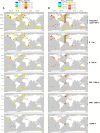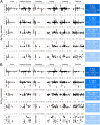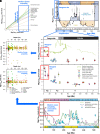Global variability in seawater Mg:Ca and Sr:Ca ratios in the modern ocean
- PMID: 32843340
- PMCID: PMC7486706
- DOI: 10.1073/pnas.1918943117
Global variability in seawater Mg:Ca and Sr:Ca ratios in the modern ocean
Erratum in
-
Correction for Lebrato et al., Global variability in seawater Mg:Ca and Sr:Ca ratios in the modern ocean.Proc Natl Acad Sci U S A. 2021 Dec 7;118(49):e2119099118. doi: 10.1073/pnas.2119099118. Proc Natl Acad Sci U S A. 2021. PMID: 34845038 Free PMC article. No abstract available.
Abstract
Seawater Mg:Ca and Sr:Ca ratios are biogeochemical parameters reflecting the Earth-ocean-atmosphere dynamic exchange of elements. The ratios' dependence on the environment and organisms' biology facilitates their application in marine sciences. Here, we present a measured single-laboratory dataset, combined with previous data, to test the assumption of limited seawater Mg:Ca and Sr:Ca variability across marine environments globally. High variability was found in open-ocean upwelling and polar regions, shelves/neritic and river-influenced areas, where seawater Mg:Ca and Sr:Ca ratios range from ∼4.40 to 6.40 mmol:mol and ∼6.95 to 9.80 mmol:mol, respectively. Open-ocean seawater Mg:Ca is semiconservative (∼4.90 to 5.30 mol:mol), while Sr:Ca is more variable and nonconservative (∼7.70 to 8.80 mmol:mol); both ratios are nonconservative in coastal seas. Further, the Ca, Mg, and Sr elemental fluxes are connected to large total alkalinity deviations from International Association for the Physical Sciences of the Oceans (IAPSO) standard values. Because there is significant modern seawater Mg:Ca and Sr:Ca ratios variability across marine environments we cannot absolutely assume that fossil archives using taxa-specific proxies reflect true global seawater chemistry but rather taxa- and process-specific ecosystem variations, reflecting regional conditions. This variability could reconcile secular seawater Mg:Ca and Sr:Ca ratio reconstructions using different taxa and techniques by assuming an error of 1 to 1.50 mol:mol, and 1 to 1.90 mmol:mol, respectively. The modern ratios' variability is similar to the reconstructed rise over 20 Ma (Neogene Period), nurturing the question of seminonconservative behavior of Ca, Mg, and Sr over modern Earth geological history with an overlooked environmental effect.
Keywords: Mg:Ca; Sr:Ca; biogeochemistry; global; seawater.
Copyright © 2020 the Author(s). Published by PNAS.
Conflict of interest statement
The authors declare no competing interest.
Figures





References
-
- Whitfield M., The mean oceanic residence time (MORT) concept–A rationalisation. Mar. Chem. 8, 101–123 (1979).
-
- Drever J. L., The Geochemistry of Natural Waters, (Prentice-Hall, 1982).
-
- Ries J., Review: Geological and experimental evidence for secular variation in seawater Mg/Ca (calcite-aragonite seas) and its effects on marine biological calcification. Biogeosciences 7, 2795–2849 (2010).
-
- Broecker W., Yu J., What do we know about the evolution of Mg to Ca ratios in seawater? Paleoceanogr. Paleoclimatol. 26, PA3203 (2011).
-
- Hardie L. A., Secular variation in seawater chemistry: An explanation for the coupled secular variation in the mineralogies of marine limestones and potash evaporites over the past 600 my. Geology 24, 279–283 (1996).
Publication types
LinkOut - more resources
Full Text Sources
Research Materials

